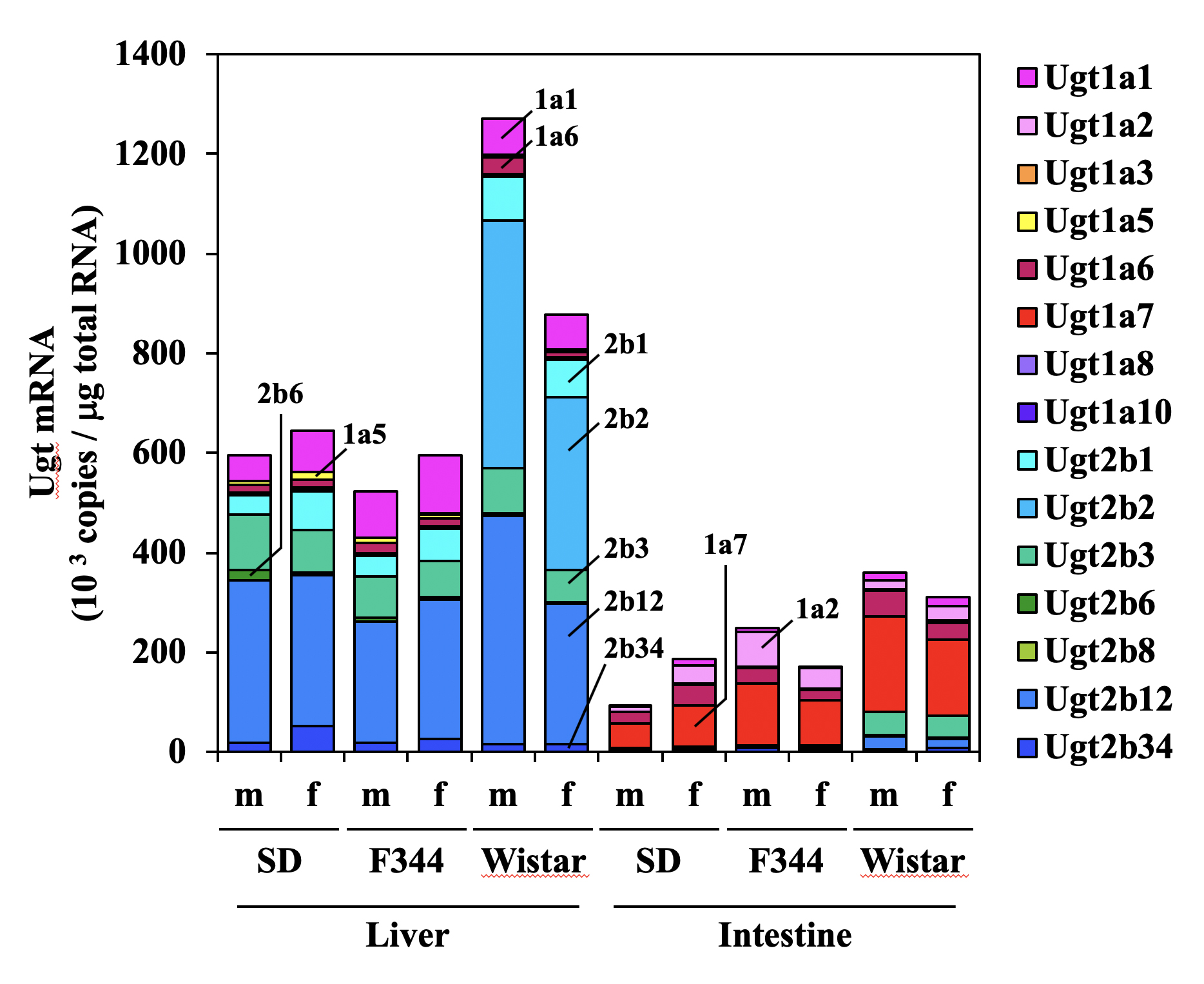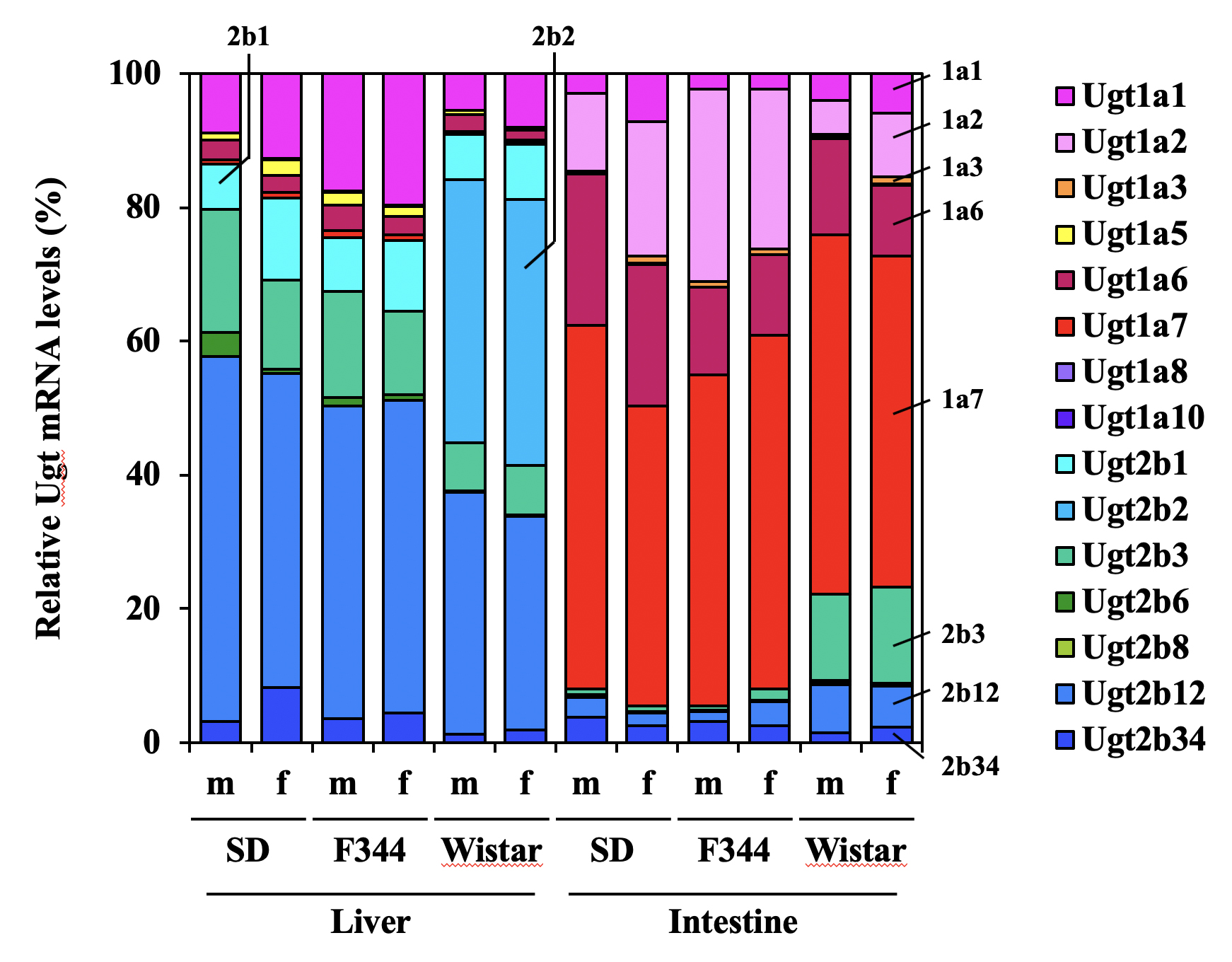Abstract:
Rats are used commonly in nonclinical drug-development studies (DDS). Miki Nakajima and colleagues at Kanazawa University (Kanazawa, Japan) quantified hepatic and intestinal mRNA expression of uridine 5'-diphospho-glucuronosyltransferase (Ugt) isoforms in rats. They revealed strain- and sex-based differences in expression of Ugts in rats. This study would be helpful for pharmaceutical scientists in choosing the strains and sex of rats for DDS.
In pharmaceutical companies, rats are used commonly in nonclinical studies to investigate the safety, efficacy, and pharmacokinetic profiles of drug candidates before they are entered into clinical studies. Most compounds administered via the oral route are metabolized in the liver and intestine, so the metabolism is a key determinant of pharmacokinetics.
The uridine 5'-diphospho-glucuronosyltransferase (Ugt) superfamily is one of the major groups of drug-metabolizing enzymes. They catalyze the glucuronidation of compounds to increase their water solubility and enhance their excretion through bile and urine. Ugt isoforms, categorized into Ugt1 or Ugt2 families, show different (but sometimes overlapping) substrate specificity. To understand or predict the potential for glucuronidation, information about the abundance and metabolic potencies of each Ugt isoform is required. Most importantly, quantitative evaluation of Ugts in rats has not been carried out.
To address the issue, Miki Nakajima and colleagues at Kanazawa University (Kanazawa, Japan) measured the absolute mRNA expression of Ugts in the liver and small intestine of male and female Sprague–Dawley (SD), Fischer 344 (F344), and Wistar rats by quantitative reverse transcription-polymerase chain reaction. In rats, there are eight Ugt1a isoforms (Ugt1a1, 2, 3, 5, 6, 7, 8, and 10) and seven Ugt2b isoforms (Ugt2b1, 2, 3, 6, 8, 12, and 34). The sum of mRNA expression of Ugts expressed in the liver was 2–6-fold higher than that in the small intestine regardless of the strain or sex of rats. In the liver, expression of Ugt2b mRNA represented ~80% of total expression of Ugt mRNA whereas, in the small intestine, expression of Ugt1a mRNA accounted for ~90%.
Particularly interesting data were obtained for expression of Ugts in different rat strains. Ugt2b2 was expressed specifically in the livers of Wistar rats, and resulted in twofold higher expression of total hepatic Ugt mRNA in Wistar rats than that in the other strains tested. This difference in expression between rat strains would result in differences in the glucuronidation of androsterone, lithocholic acid, and triiodothyronine, and substrates of Ugt2b2 between rat strains. Differences between strains were also observed in intestinal Ugts. Ugt2b3 expression was prominently higher in the small intestine of Wistar rats than that in the other strains tested. Ugt2b3 catalyzes the glucuronidation of aromatic primary amines. Therefore, differences in rat strains with regard to intestinal expression of Ugt2b3 could contribute to differences in rat strains in terms of drug pharmacokinetics. Therefore, Nakajima et al. provided a helpful clue for the selection of rat strains, showing that Ugt expression in Wistar rats was different from that in the other strains tested.
Hepatic expression of Ugt1a10 was significantly higher in females than in males in all strains (though the copy number was much lower than that for other isoforms) evaluated. In Wistar rats, the sum of hepatic expression of the Ugt2b isoform was higher in males than in females. In F344 rats, the sum of intestinal expression of the Ugt1a isoform was higher in males in females. Sex hormones are known to regulate expression of some Ugts, which might explain the differences in Ugt expression between sexes.
This was the first study to comprehensively quantify hepatic and intestinal mRNA expression of Ugt isoforms in SD, F344, and Wistar rats, which are used commonly for nonclinical studies. These results would be helpful for pharmaceutical scientists in choosing the strain and sex of rats for future studies.

Figure 1.
Ugt mRNA expression levels in the liver and small intestine from male and female SD, F344, and Wistar rats. Sum of the absolute mRNA expression levels of Ugt1a and Ugt2b in rats. f, female; m, males.

Figure 2.
Percentage of each Ugt isoform mRNA level in the sum of all of the Ugt levels. f, female; m, males.
Article
Quantitative Analysis of UDP-Glucuronosyltransferase Ugt1a and Ugt2b mRNA Expression in the Rat Liver and Small Intestine: Sex and Strain Differences
Journal: Drug Metabolism and Disposition
Authors: Takaya Kutsukake, Yoichi Furukawa, Kyoko Ondo, Saki Gotoh, Tatsuki Fukami and Miki Nakajima
DOI: 10.1124/dmd.118.083287



 PAGE TOP
PAGE TOP